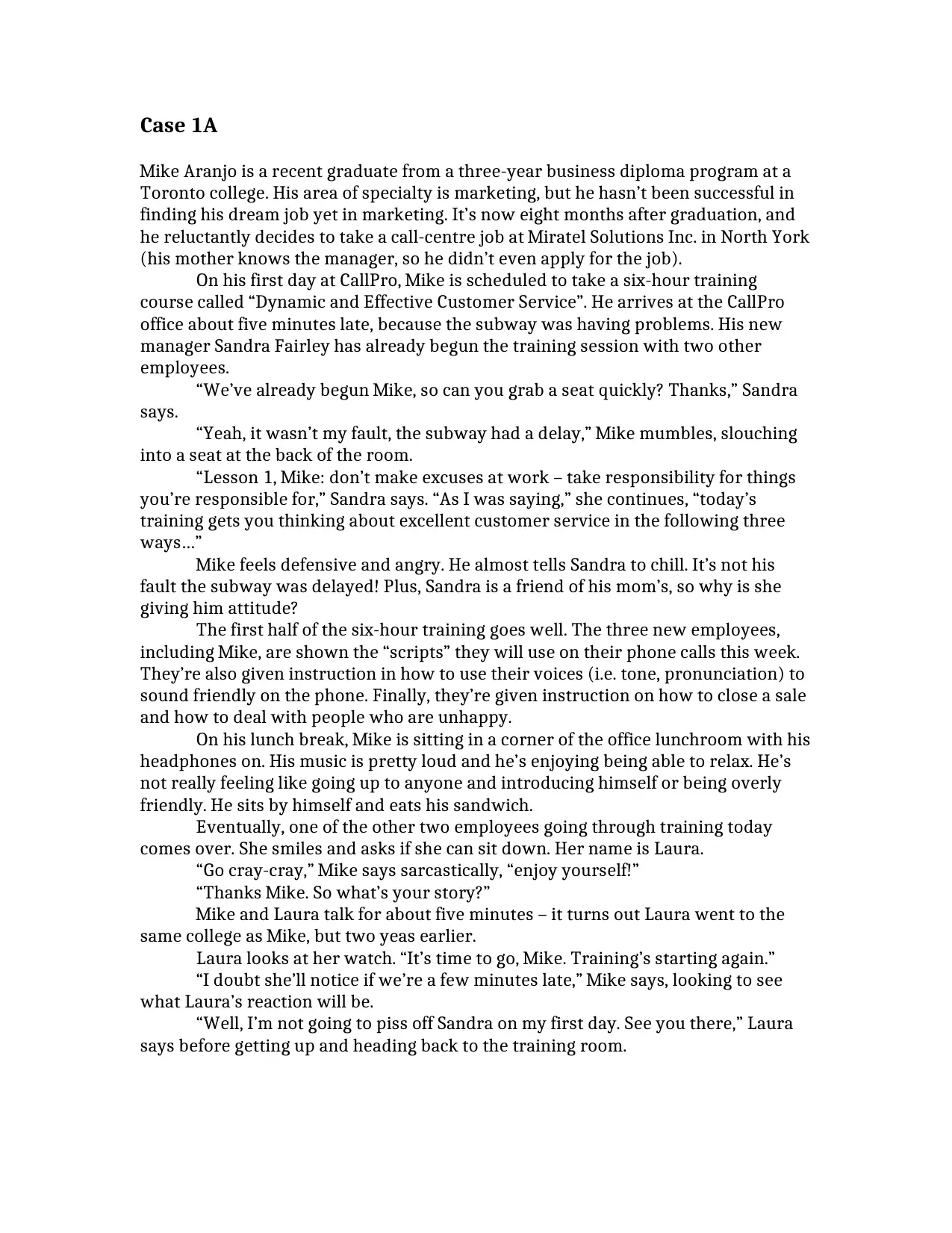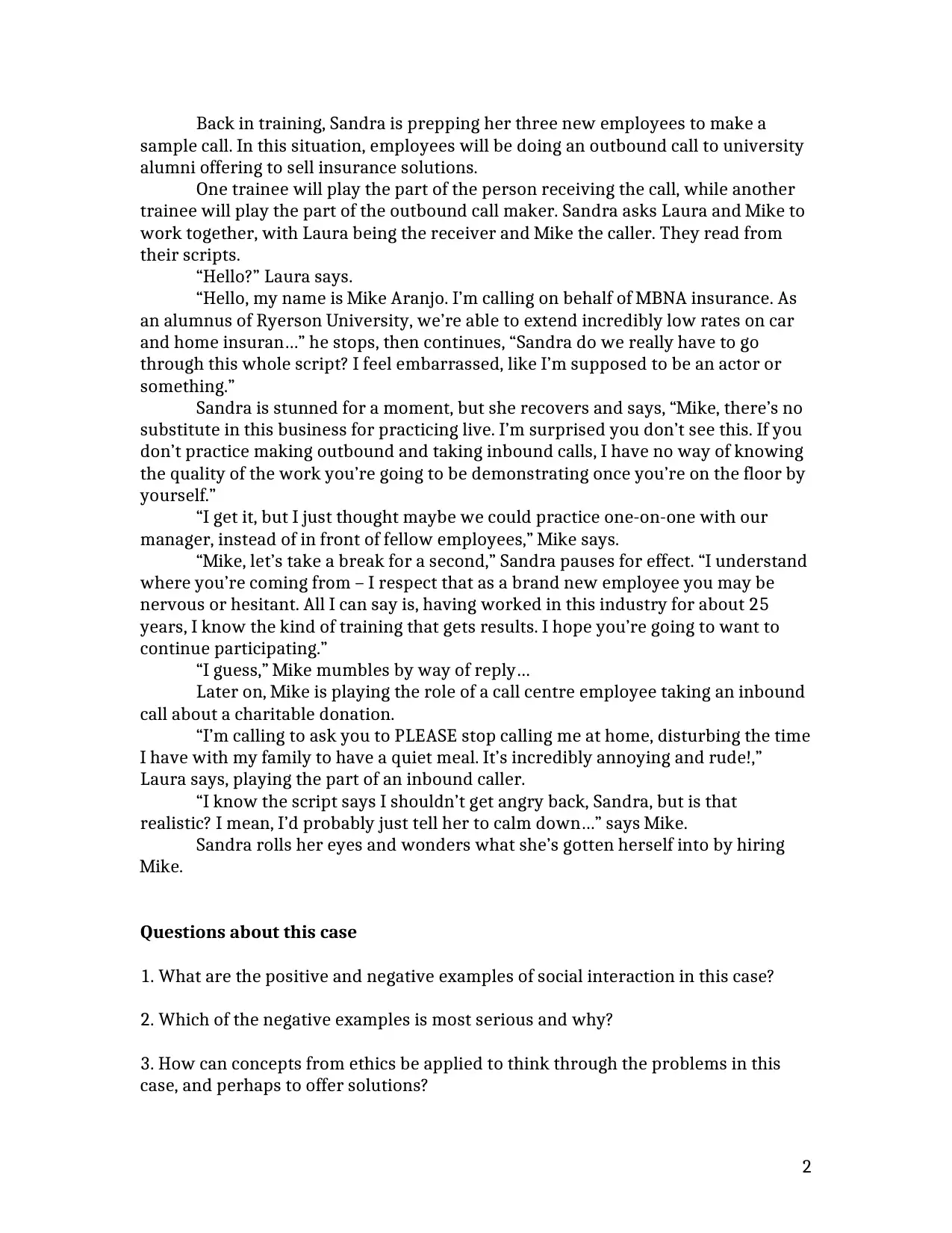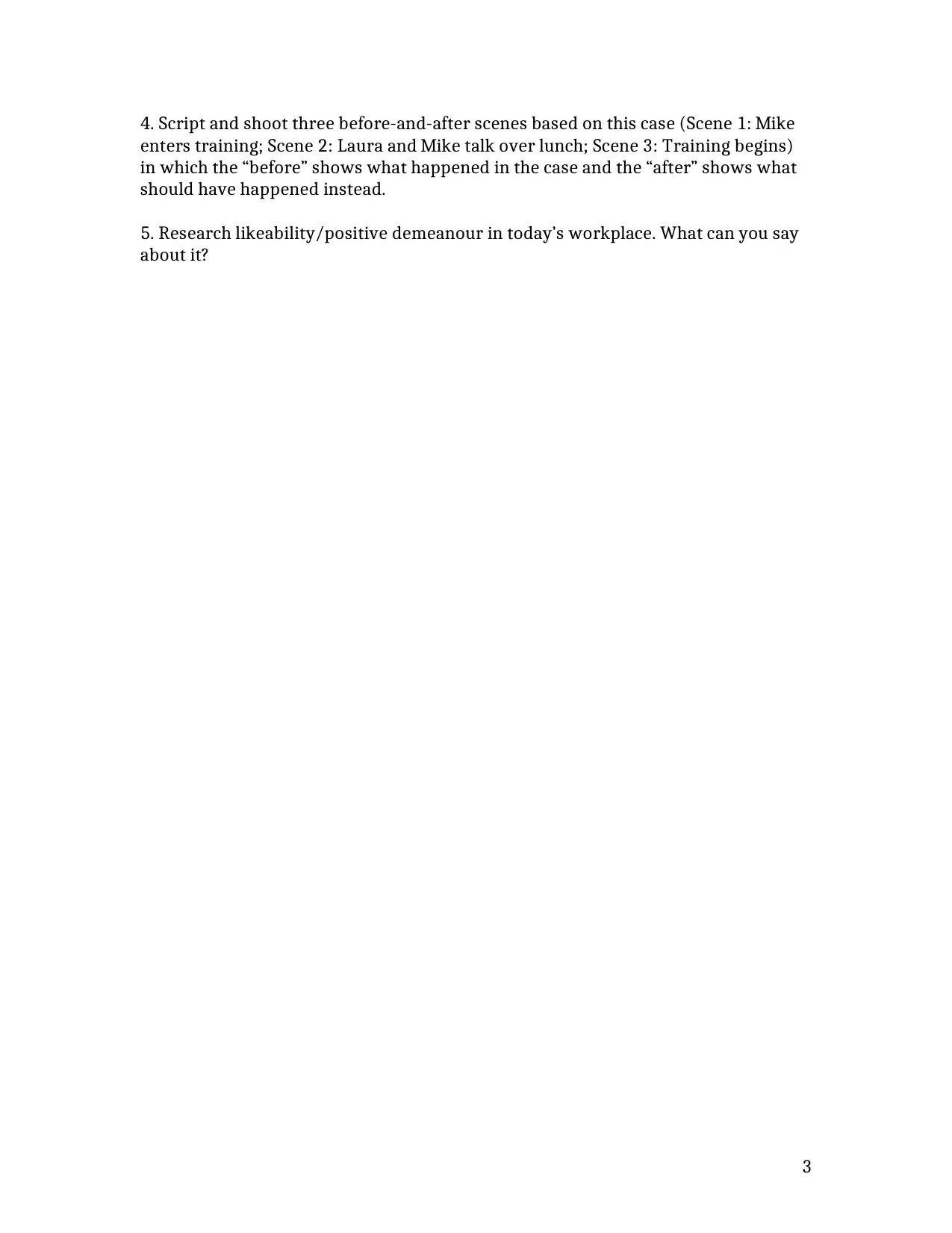Toronto College Marketing Graduate: Mike Aranjo Case Study Analysis
VerifiedAdded on 2019/09/18
|3
|1252
|779
Case Study
AI Summary
This case study focuses on Mike Aranjo, a recent marketing graduate, and his experiences in a customer service training program at Miratel Solutions Inc. The case explores various aspects of social interaction, including communication styles, reactions to feedback, and ethical considerations in the workplace. It presents positive and negative examples of interactions, prompting analysis of their impact. The assignment includes questions about identifying the most serious negative examples, applying ethical concepts to address the problems, and suggesting improved scenarios through before-and-after scenes. Furthermore, the case study requires research into the importance of likeability and positive demeanor in today's workplace, providing a comprehensive analysis of Mike's challenges and opportunities for improvement.

Case 1A
Mike Aranjo is a recent graduate from a three-year business diploma program at a
Toronto college. His area of specialty is marketing, but he hasn’t been successful in
finding his dream job yet in marketing. It’s now eight months after graduation, and
he reluctantly decides to take a call-centre job at Miratel Solutions Inc. in North York
(his mother knows the manager, so he didn’t even apply for the job).
On his first day at CallPro, Mike is scheduled to take a six-hour training
course called “Dynamic and Effective Customer Service”. He arrives at the CallPro
office about five minutes late, because the subway was having problems. His new
manager Sandra Fairley has already begun the training session with two other
employees.
“We’ve already begun Mike, so can you grab a seat quickly? Thanks,” Sandra
says.
“Yeah, it wasn’t my fault, the subway had a delay,” Mike mumbles, slouching
into a seat at the back of the room.
“Lesson 1, Mike: don’t make excuses at work – take responsibility for things
you’re responsible for,” Sandra says. “As I was saying,” she continues, “today’s
training gets you thinking about excellent customer service in the following three
ways…”
Mike feels defensive and angry. He almost tells Sandra to chill. It’s not his
fault the subway was delayed! Plus, Sandra is a friend of his mom’s, so why is she
giving him attitude?
The first half of the six-hour training goes well. The three new employees,
including Mike, are shown the “scripts” they will use on their phone calls this week.
They’re also given instruction in how to use their voices (i.e. tone, pronunciation) to
sound friendly on the phone. Finally, they’re given instruction on how to close a sale
and how to deal with people who are unhappy.
On his lunch break, Mike is sitting in a corner of the office lunchroom with his
headphones on. His music is pretty loud and he’s enjoying being able to relax. He’s
not really feeling like going up to anyone and introducing himself or being overly
friendly. He sits by himself and eats his sandwich.
Eventually, one of the other two employees going through training today
comes over. She smiles and asks if she can sit down. Her name is Laura.
“Go cray-cray,” Mike says sarcastically, “enjoy yourself!”
“Thanks Mike. So what’s your story?”
Mike and Laura talk for about five minutes – it turns out Laura went to the
same college as Mike, but two yeas earlier.
Laura looks at her watch. “It’s time to go, Mike. Training’s starting again.”
“I doubt she’ll notice if we’re a few minutes late,” Mike says, looking to see
what Laura’s reaction will be.
“Well, I’m not going to piss off Sandra on my first day. See you there,” Laura
says before getting up and heading back to the training room.
Mike Aranjo is a recent graduate from a three-year business diploma program at a
Toronto college. His area of specialty is marketing, but he hasn’t been successful in
finding his dream job yet in marketing. It’s now eight months after graduation, and
he reluctantly decides to take a call-centre job at Miratel Solutions Inc. in North York
(his mother knows the manager, so he didn’t even apply for the job).
On his first day at CallPro, Mike is scheduled to take a six-hour training
course called “Dynamic and Effective Customer Service”. He arrives at the CallPro
office about five minutes late, because the subway was having problems. His new
manager Sandra Fairley has already begun the training session with two other
employees.
“We’ve already begun Mike, so can you grab a seat quickly? Thanks,” Sandra
says.
“Yeah, it wasn’t my fault, the subway had a delay,” Mike mumbles, slouching
into a seat at the back of the room.
“Lesson 1, Mike: don’t make excuses at work – take responsibility for things
you’re responsible for,” Sandra says. “As I was saying,” she continues, “today’s
training gets you thinking about excellent customer service in the following three
ways…”
Mike feels defensive and angry. He almost tells Sandra to chill. It’s not his
fault the subway was delayed! Plus, Sandra is a friend of his mom’s, so why is she
giving him attitude?
The first half of the six-hour training goes well. The three new employees,
including Mike, are shown the “scripts” they will use on their phone calls this week.
They’re also given instruction in how to use their voices (i.e. tone, pronunciation) to
sound friendly on the phone. Finally, they’re given instruction on how to close a sale
and how to deal with people who are unhappy.
On his lunch break, Mike is sitting in a corner of the office lunchroom with his
headphones on. His music is pretty loud and he’s enjoying being able to relax. He’s
not really feeling like going up to anyone and introducing himself or being overly
friendly. He sits by himself and eats his sandwich.
Eventually, one of the other two employees going through training today
comes over. She smiles and asks if she can sit down. Her name is Laura.
“Go cray-cray,” Mike says sarcastically, “enjoy yourself!”
“Thanks Mike. So what’s your story?”
Mike and Laura talk for about five minutes – it turns out Laura went to the
same college as Mike, but two yeas earlier.
Laura looks at her watch. “It’s time to go, Mike. Training’s starting again.”
“I doubt she’ll notice if we’re a few minutes late,” Mike says, looking to see
what Laura’s reaction will be.
“Well, I’m not going to piss off Sandra on my first day. See you there,” Laura
says before getting up and heading back to the training room.
Paraphrase This Document
Need a fresh take? Get an instant paraphrase of this document with our AI Paraphraser

Back in training, Sandra is prepping her three new employees to make a
sample call. In this situation, employees will be doing an outbound call to university
alumni offering to sell insurance solutions.
One trainee will play the part of the person receiving the call, while another
trainee will play the part of the outbound call maker. Sandra asks Laura and Mike to
work together, with Laura being the receiver and Mike the caller. They read from
their scripts.
“Hello?” Laura says.
“Hello, my name is Mike Aranjo. I’m calling on behalf of MBNA insurance. As
an alumnus of Ryerson University, we’re able to extend incredibly low rates on car
and home insuran…” he stops, then continues, “Sandra do we really have to go
through this whole script? I feel embarrassed, like I’m supposed to be an actor or
something.”
Sandra is stunned for a moment, but she recovers and says, “Mike, there’s no
substitute in this business for practicing live. I’m surprised you don’t see this. If you
don’t practice making outbound and taking inbound calls, I have no way of knowing
the quality of the work you’re going to be demonstrating once you’re on the floor by
yourself.”
“I get it, but I just thought maybe we could practice one-on-one with our
manager, instead of in front of fellow employees,” Mike says.
“Mike, let’s take a break for a second,” Sandra pauses for effect. “I understand
where you’re coming from – I respect that as a brand new employee you may be
nervous or hesitant. All I can say is, having worked in this industry for about 25
years, I know the kind of training that gets results. I hope you’re going to want to
continue participating.”
“I guess,” Mike mumbles by way of reply…
Later on, Mike is playing the role of a call centre employee taking an inbound
call about a charitable donation.
“I’m calling to ask you to PLEASE stop calling me at home, disturbing the time
I have with my family to have a quiet meal. It’s incredibly annoying and rude!,”
Laura says, playing the part of an inbound caller.
“I know the script says I shouldn’t get angry back, Sandra, but is that
realistic? I mean, I’d probably just tell her to calm down…” says Mike.
Sandra rolls her eyes and wonders what she’s gotten herself into by hiring
Mike.
Questions about this case
1. What are the positive and negative examples of social interaction in this case?
2. Which of the negative examples is most serious and why?
3. How can concepts from ethics be applied to think through the problems in this
case, and perhaps to offer solutions?
2
sample call. In this situation, employees will be doing an outbound call to university
alumni offering to sell insurance solutions.
One trainee will play the part of the person receiving the call, while another
trainee will play the part of the outbound call maker. Sandra asks Laura and Mike to
work together, with Laura being the receiver and Mike the caller. They read from
their scripts.
“Hello?” Laura says.
“Hello, my name is Mike Aranjo. I’m calling on behalf of MBNA insurance. As
an alumnus of Ryerson University, we’re able to extend incredibly low rates on car
and home insuran…” he stops, then continues, “Sandra do we really have to go
through this whole script? I feel embarrassed, like I’m supposed to be an actor or
something.”
Sandra is stunned for a moment, but she recovers and says, “Mike, there’s no
substitute in this business for practicing live. I’m surprised you don’t see this. If you
don’t practice making outbound and taking inbound calls, I have no way of knowing
the quality of the work you’re going to be demonstrating once you’re on the floor by
yourself.”
“I get it, but I just thought maybe we could practice one-on-one with our
manager, instead of in front of fellow employees,” Mike says.
“Mike, let’s take a break for a second,” Sandra pauses for effect. “I understand
where you’re coming from – I respect that as a brand new employee you may be
nervous or hesitant. All I can say is, having worked in this industry for about 25
years, I know the kind of training that gets results. I hope you’re going to want to
continue participating.”
“I guess,” Mike mumbles by way of reply…
Later on, Mike is playing the role of a call centre employee taking an inbound
call about a charitable donation.
“I’m calling to ask you to PLEASE stop calling me at home, disturbing the time
I have with my family to have a quiet meal. It’s incredibly annoying and rude!,”
Laura says, playing the part of an inbound caller.
“I know the script says I shouldn’t get angry back, Sandra, but is that
realistic? I mean, I’d probably just tell her to calm down…” says Mike.
Sandra rolls her eyes and wonders what she’s gotten herself into by hiring
Mike.
Questions about this case
1. What are the positive and negative examples of social interaction in this case?
2. Which of the negative examples is most serious and why?
3. How can concepts from ethics be applied to think through the problems in this
case, and perhaps to offer solutions?
2

4. Script and shoot three before-and-after scenes based on this case (Scene 1: Mike
enters training; Scene 2: Laura and Mike talk over lunch; Scene 3: Training begins)
in which the “before” shows what happened in the case and the “after” shows what
should have happened instead.
5. Research likeability/positive demeanour in today’s workplace. What can you say
about it?
3
enters training; Scene 2: Laura and Mike talk over lunch; Scene 3: Training begins)
in which the “before” shows what happened in the case and the “after” shows what
should have happened instead.
5. Research likeability/positive demeanour in today’s workplace. What can you say
about it?
3
⊘ This is a preview!⊘
Do you want full access?
Subscribe today to unlock all pages.

Trusted by 1+ million students worldwide
1 out of 3
Your All-in-One AI-Powered Toolkit for Academic Success.
+13062052269
info@desklib.com
Available 24*7 on WhatsApp / Email
![[object Object]](/_next/static/media/star-bottom.7253800d.svg)
Unlock your academic potential
Copyright © 2020–2025 A2Z Services. All Rights Reserved. Developed and managed by ZUCOL.
